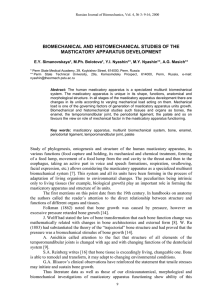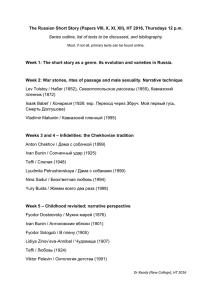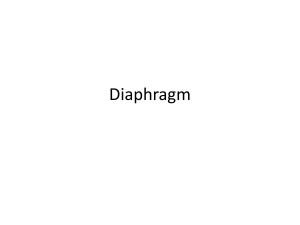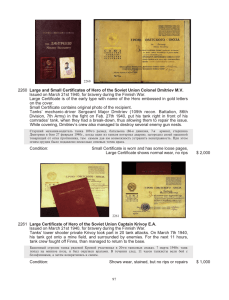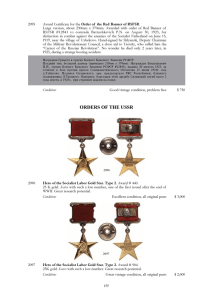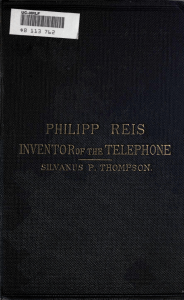FUNCTIONAL ADAPTO - COMPENSATING MECHANISMS OF THE
реклама
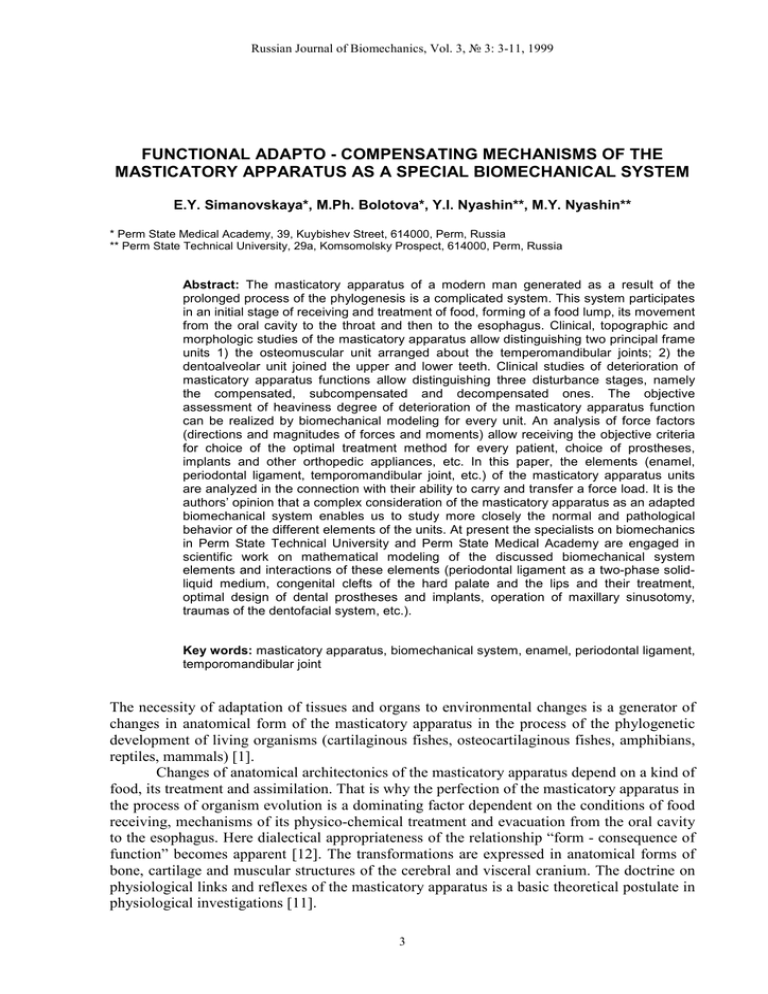
Russian Journal of Biomechanics, Vol. 3, № 3: 3-11, 1999 FUNCTIONAL ADAPTO - COMPENSATING MECHANISMS OF THE MASTICATORY APPARATUS AS A SPECIAL BIOMECHANICAL SYSTEM E.Y. Simanovskaya*, M.Ph. Bolotova*, Y.I. Nyashin**, M.Y. Nyashin** * Perm State Medical Academy, 39, Kuybishev Street, 614000, Perm, Russia ** Perm State Technical University, 29a, Komsomolsky Prospect, 614000, Perm, Russia Abstract: The masticatory apparatus of a modern man generated as a result of the prolonged process of the phylogenesis is a complicated system. This system participates in an initial stage of receiving and treatment of food, forming of a food lump, its movement from the oral cavity to the throat and then to the esophagus. Clinical, topographic and morphologic studies of the masticatory apparatus allow distinguishing two principal frame units 1) the osteomuscular unit arranged about the temperomandibular joints; 2) the dentoalveolar unit joined the upper and lower teeth. Clinical studies of deterioration of masticatory apparatus functions allow distinguishing three disturbance stages, namely the compensated, subcompensated and decompensated ones. The objective assessment of heaviness degree of deterioration of the masticatory apparatus function can be realized by biomechanical modeling for every unit. An analysis of force factors (directions and magnitudes of forces and moments) allow receiving the objective criteria for choice of the optimal treatment method for every patient, choice of prostheses, implants and other orthopedic appliances, etc. In this paper, the elements (enamel, periodontal ligament, temporomandibular joint, etc.) of the masticatory apparatus units are analyzed in the connection with their ability to carry and transfer a force load. It is the authors’ opinion that a complex consideration of the masticatory apparatus as an adapted biomechanical system enables us to study more closely the normal and pathological behavior of the different elements of the units. At present the specialists on biomechanics in Perm State Technical University and Perm State Medical Academy are engaged in scientific work on mathematical modeling of the discussed biomechanical system elements and interactions of these elements (periodontal ligament as a two-phase solidliquid medium, congenital clefts of the hard palate and the lips and their treatment, optimal design of dental prostheses and implants, operation of maxillary sinusotomy, traumas of the dentofacial system, etc.). Key words: masticatory apparatus, biomechanical system, enamel, periodontal ligament, temporomandibular joint The necessity of adaptation of tissues and organs to environmental changes is a generator of changes in anatomical form of the masticatory apparatus in the process of the phylogenetic development of living organisms (cartilaginous fishes, osteocartilaginous fishes, amphibians, reptiles, mammals) [1]. Changes of anatomical architectonics of the masticatory apparatus depend on a kind of food, its treatment and assimilation. That is why the perfection of the masticatory apparatus in the process of organism evolution is a dominating factor dependent on the conditions of food receiving, mechanisms of its physico-chemical treatment and evacuation from the oral cavity to the esophagus. Here dialectical appropriateness of the relationship “form - consequence of function” becomes apparent [12]. The transformations are expressed in anatomical forms of bone, cartilage and muscular structures of the cerebral and visceral cranium. The doctrine on physiological links and reflexes of the masticatory apparatus is a basic theoretical postulate in physiological investigations [11]. 3 Russian Journal of Biomechanics, Vol. 3, № 3: 3-11, 1999 The masticatory apparatus of a modern man is a complicated multiunit system ensuring an initial stage of receiving and treatment of food, forming of a food lump, its movement from the oral cavity to the throat and then to the esophagus. The mastication mechanism involves the combination of the unconditioned and conditioned reflexes of different degree of complexity. Osteomuscular links of the masticatory apparatus take part in the masticatory regulation. Clinical, topographic and morphological studies of the masticatory apparatus allow distinguishing two principal frame units: 1) the osteomuscular unit arranged within the temporomandibular joint, 2) the dentoalveolar unit joined the upper and lower teeth (Fig. 1). For scientific and practical stomatology, information on objective function of these units and force magnitudes in different links of the masticatory apparatus is very important. This question has a special interest in connection with diseases and injuries of the dentofacial system. These anomalies have the congenital genesis as well as appear in the process of organism vital activity. They are accompanied by local and generalized deformations of tissues and organs. It causes deterioration of process of force load transformation, appearance of overloading and underloading zones and as a result progressive dysfunction of the system as a whole. Clinical study of deterioration of the masticatory apparatus function allows distinguishing three stages. 1. Compensated stage: defects of the enamel and the dentine (caries, hypoplasia, aplasia); anomalies of form and quantity of the teeth and their disposition in the dental arch; unreplaced single defects of the dental arch; etc. 2. Subcompensated stage: unreplaced plural defects of the dental arch; sagittal, vertical and transversal malocclusion; chronic arthritis; dysartrosis of the temperomandibular joint; extra-articular contracture; tumor formations. 3. Decompensated stage: absence of all teeth; atrophy of the alveolar process; defects of the alveolar process, the maxilla and the mandible; ankylosis of the temporomandibular joint; congenital cleft of the upper lip, the alveolar process, the soft and hard palates; jaw neoplasm. 5 4 II 1 2 7 I 1 8 6 Fig. 1. Scheme of disposition of frame units of facial sceleton. I. Osteomuscular unit in the region of temperomandibular articulation 1. Head of joint process. 2. Articular disc. 3. Articular fossa. 4. Articular tubercle. 5. Zygomatic arch. 6. Coronal process. II. Multiunit dentoalveolar unit joined dental arches of the maxilla and mandible. 7. Dental arch. 8. Alveolar process. 4 Russian Journal of Biomechanics, Vol. 3, № 3: 3-11, 1999 Fig. 2. Cranium in disassembled form. An objective assessment of heaviness degree of deterioration of the masticatory apparatus can be accomplished by mathematical modeling for every unit. The changes of force factors (direction, magnitude, velocity of change) are objective criteria for choice of correction time, appliances, prostheses, etc. The data obtained by this method have many advantages over clinical and physiological methods of the masticatory apparatus assessment which are used at present (physiological masticatory test, masticatiography, gnathodynamometry, myography) [7, 8, 11]. Biomechanical methods are more objective, informative and mathematically justified. The study of mechanism of force load transformation which arises in mastication process shows the presence of the adapto-compensating system. This system coordinates force action and by this means prevents from deterioration of dental and bone tissues of the visceral and cerebral cranium. 5 Russian Journal of Biomechanics, Vol. 3, № 3: 3-11, 1999 The supporting sections of the masticatory apparatus carry and transform a functional load. They include dental arches and numerous bones of the visceral cranium and have anatomical peculiarities. For example, the bones of the visceral and cerebral cranium, exclusive of the mandible, are connected between themselves by syndesmosises. By them the ends of connective fibers grow into the bones, connecting them between themselves (18 bones of the visceral cranium, 32 dentoalveolar articulations, 2 temporomandibular joints, 7 bones of the cerebral cranium) (Fig. 2). In mastication process, the force load is initially carried by teeth. Note that their anatomical form and structure are unique in the organism. The enamel has the highest hardness which ranges up to about 400 kg/mm2 [11]. The enamel thickness is variable from 0.01 mm near the dental neck to 3.5 mm near the masticatory surface in the tubera area. In paper [3], the histoarchitectonics of the enamel Fig. 3. Scheme of disposition of a tooth in was investigated and peculiarities of the enamel the cavity, its structure, fixation system prisms disposition were found. It was the authors’ and directions of force load under opinion that the general appropriateness is a Smastication. shaped prism bend with formation of different angles in relation to the enamel surface. The magnitudes of these angles are distinct in different parts of the dental crown and in different dental integration. For example, the incisors have gradual change of inclination angle of the enamel prisms from the horizontal direction in the neck zone to 25?-28? near the equator and close to the cutting edge this angle is right. The canines have almost identical appropriateness: near the neck the prisms are disposed radially, near the equator the enamel prisms angle with the horizontal plane is 45?-50?, at the cutting edge the prisms bundles are almost vertical. The molar teeth in contrast to the incisors and the canines have the masticatory surface with increased twisting of the prism bundles. The formation of curls, especially in zones of the prism knolls, resembles a disposition of a crushed grass with a sharp deviation aside. The mentioned data show the causal and effective relationship between tooth architectonics and functional load. This relationship verifies the dependence of the enamel structure on a load. The periodontal ligament is a dense connective tissue that surrounds the root of the tooth and attaches it to the alveolar bone. The periodontal ligament plays a broad spectrum of functions. The primary functions are providing tooth support and blood supply. It was experimentally shown [6, 17] that there are the ways for fluid movement in the periodontal ligament and that the periodontal ligament fluid may flow under pressure. The periodontal ligament fluid flow and its effect on load amortization was theoretically investigated in [18]. The influence of the periodontal ligament on the adapto-compensating process of the orthodontic tooth movement was biomechanically studied in [16]. The process of transformation of masticatory pressure spreads to the tooth root system. It can be justifies by anatomical form, sizes, number and geometrical disposition of teeth roots (Fig. 4). The examples of active participation of bone tissues in the processes of force unloading are intumescence of cortical layer (counterfort) in the maxilla and formation of spongy substance consolidation zones in the mandible. These zones are situated according 6 Russian Journal of Biomechanics, Vol. 3, № 3: 3-11, 1999 Fig. 4. Interrelation of permanent teeth of the maxilla and the mandible: form, quantity, root geometry in dependence of their load. Fig. 5. Disposition of force loads arising in process of mastication and their transformation. to the lines of the maximal force load. The justification of this fact is the absence of it in the children’s jawbone structure. The force load weakened by successively situated amortizing structures of the mandible is distributed in the direction to the temporomandibular joint. Here the interarticular disc takes the amortizing function upon itself. It prevents a thin bone plate of the temporal bone from deterioration. This bone separates the joint cavities and the cerebral cranium. In the maxilla the load reduction occurs with the participation of the symmetrically situated counterforts. The frontonasal counterfort balances the forces developed by the canines, the zyromatic counterfort does the forces developed by the masticatory teeth, the pterygopalatine 7 Russian Journal of Biomechanics, Vol. 3, № 3: 3-11, 1999 6 5 7 4 8 1 9 2 10 3 11 I 12 II Fig. 6. Scheme of disposition of auxiliary units of masticatory apparatus. I. Anterior vestibular apparatus. 1. Upper lip. 2. Lower lip. 3. Entrance to the mouth. 4. Teeth and alveolar process. 5. Oral cavity. 6. Hard palate. 7. Tongue. II. Posterior palatopharyngeal lock. 8. Soft palate. 9. Root of the tongue. 10. Epiglottis. 11. Trachea. 12. Esophagus. counterfort does the forces developed by the posterior teeth. The palatal counterfort balances the forces acting in the transversal direction. The correlated, successively situated, coordinating mechanisms of the masticatory apparatus ensure smooth slackening of a load and its attenuation within the dentofacial system (Fig. 5). Any pathological process of both congenital character and connected with disease or injury arising at any age can disturb functioning links of the specialized system. It results in dysfunction of mastication and facial skeleton deformation of different heaviness degree. From this viewpoint it is important to elucidate the causes of these pathologies using biomechanical modeling. The biomechanical investigation of behavior of the children’s hard palate bone structures with congenital cleft was conducted in [13, 14]. The author created the mathematical model of complicated biomechanical system: disconnected palate fragments orthopedic apparatus. As a first approximation, the palate bone process was considered as a homogeneous growing cantilever loaded by an apparatus force. The algorithms to determine parameters of growth of the palate fragments were proposed and the optimal force to prevent fragments displacement from the nasal cavity to the oral cavity was found. The biomechanical analysis of the masticatory apparatus functions includes the consideration of the structural peculiarities of the soft tissue formations incorporating into the system. By this means it is very interesting to analyze the lips taking an active part in food receiving by the action of reflex contraction of the orbital mouth muscle. This muscle functions as a sphincter-lock and contributes to subsequent food movement to the oral cavity. The oral cavity is a system of fissures opened to each other and surrounded by walls and the oral cavity organs projecting from them [5]. In the oral cavity food is subjected to tasting, 8 Russian Journal of Biomechanics, Vol. 3, № 3: 3-11, 1999 physical and chemical treatment and is transformed into a food lump. The important role belongs to the muscular organ (tongue) experienced complicated changes in the masticatory apparatus phylogenesis and having universal sensory and motor functions. The tongue is a strong auxiliary muscular masticatory organ fixed only at the region of its root. It functions according to the principle of the first kind lever. Displacements of the middle and especially front parts are accomplished with large amplitudes. It allows the tongue to contact with almost all the parts of the oral cavity forming by this means distinct miniunits. The tongue takes part in formation of a food lump and its displacement. The lump moves firstly to the tongue back and then to the tongue root. The subsequent path of the food lump to the throat is regulated by the posterior palatopharyngeal lock which is analogous to the anterior vestibular lock. The palatopharyngeal lock is generated by six pair muscles of the soft palate, the throat and the tongue root (m. Tensor, m. Levator velli palatini, m. Uvulae, m. Palatopharyngeus, m. Constrictor superior, m. palatoglossus). Transition of the food lump into the throat is possible only under preservation of anatomical integrity of all the elements of the palatopharyngeal lock. For this purpose it is necessary 1) to shut the entrance to the nasal cavity by reflex contraction of the soft palate muscles raising the palatal curtain, 2) to shut the entrance to the trachea by displacement of the epiglottis under the pressure of the contracting muscles of the tongue root. Movement of the food lump into the throat and further to the esophagus is possible only under anatomical integrity of all the elements of the palatopharyngeal ring. This condition is lacking in the children with congenital developmental defect of the hard and soft palate (Fig. 6). In such a manner the study of the anatomical and topographical peculiarities of tissues and organs of the masticatory apparatus not only confirms the dialectical relationship between form and functions but also proves a leading role of function as a generator of adapting processes which change and transform all the system in accordance with the life conditions. Conclusions The methodological approach must allow us to differentiate multiunit character of anatomic structure of the masticatory apparatus and to study functional mechanisms of every unit, sphincter-lock and on the basis of numerical data to create their mathematical models. These models must reflect activity of every unit by itself and integrate the masticatory apparatus as a specialized biomechanical system by normal and different pathological processes. Acknowledgements The authors would like to acknowledge financial support from the INTAS under INTAS ?97-32158. References 1. 2. 3. 4. 5. 6. ВОРОБЬЕВ В., ЯСВОИН Г. Анатомия, гистология, эмбриология полости рта и зубов. Москва, Ленинград, 1936 (in Russian). ГАВРИЛОВ Е.И. Биология пародонта и пульпы зуба. Москва, Медицина, 1969 (in Russian). ГЕМОНОВ В.В., БОЛЬШАКОВ Г.В., ЦИРЕНОВ Б.Б. Гистоархитектоника эмали зубов человека. Стоматология, 1: 5-7, 1998 (in Russian). ИВАНОВ В.С. Заболевания пародонта. Москва, Медицина, 1989 (in Russian). КУДРИН И.С. Анатомия полости рта. Москва, Медицина, 1968 (in Russian). НЯШИН М.Ю. Математическая модель периодонта. Дисс. ... канд. физикоматематических наук. Пермь, 1999 (in Russian). 9 Russian Journal of Biomechanics, Vol. 3, № 3: 3-11, 1999 7. 8. 9. 10. 11. 12. 13. 14. 15. 16. 17. 18. 19. РУБИНОВ И.С. Новая методика записи двигательной функции жевательного аппарата. Тезисы докладов VIII научной конференции. Ленинградский государственный стоматологический институт, Ленинград, 1948: 21 (in Russian). РУБИНОВ И.С. Физиологические исследования двигательной функции мягкого неба и их значение в клинике врожденных расщелин неба. Тезисы докладов XI научной сессии Ленинградского медицинского института. Ленинград, 1950: 37 (in Russian). РУБИНОВ И.С. Клинико-анатомические исследования актов жевания и глотания в норме и патологии. Автореферат дисс. ... докт. медицинских наук, Ленинград, 1952 (in Russian). РУБИНОВ И.С. Графический метод учета двигательной функции жевательного аппарата (мастикациография). Стоматология, 4: 50-54, 1954 (in Russian). РУБИНОВ И.С. Физиологические основы стоматологии. Москва, Медицина, 1965 (in Russian). DUNCAN D. Большая игра. Москва, издательство АСТ-ЛТД, 1997 (in Russian). MASICH A.G., Nyashin Y.I. Mathematical modelling of orthopedic reconstruction of children’s congenital maxillary anomaly. Russian Journal of Biomechanics, 3(1): 101-109, 1999. MASICH A.G. Formulation of initial boundary-value problem and construction of computational algorithm in simulation of growing bone tissue. Russian Journal of Biomechanics, 3(3): 32-38, 1999. MARTINKO V. Biomechanica orofacionalnej sustary. III Mechanicke vlastnosti periodoncia. Csl. Stomatologi, 83(5): 535-537, 1983 (in Czech). NYASHIN M.Y., PECHENOV V.S., RAMMERSTORFER F.G. Determination of optimal orthodontic forces. Russian Journal of Biomechanics, 1(1-2): 84–96, 1997. NYASHIN M.Y., OSIPOV A.P., BOLOTOVA M.Ph., NYASHIN Y.I., SIMANOVSKAYA E.Y. Periodontal ligament may be viewed as a porous material filled by free fluid: experimental proof. Russian Journal of Biomechanics, 3(1): 89-95, 1999. NYASHIN M.Y., BAGAUTDINOVA I.V., SIMANOVSKAYA E.Y., CHERNOPAZOV S.A. Biomechanical investigation of a trauma of the upper central incisor. Russian Journal of Biomechanics, 3(1): 96-100, 1999. NYASHIN M.Y. Unconfined compression of the periodontal ligament, intervertebral disc, articular cartilage and other permeable deformable tissues: a poroelastic analysis. Russian Journal of Biomechanics, 3(3): 23-31, 1999. ФУНКЦИОНАЛЬНО-ПРИСПОСОБИТЕЛЬНЫЕ И АДАПТАЦИОННОКОМПЕНСАТОРНЫЕ МЕХАНИЗМЫ ЖЕВАТЕЛЬНОГО АППАРАТА КАК СПЕЦИАЛИЗИРОВАННОЙ БИОМЕХАНИЧЕСКОЙ СИСТЕМЫ Е.Ю. Симановская, М.Ф. Болотова, Ю.И. Няшин, М.Ю. Няшин (Пермь, Россия) Жевательный аппарат современного человека, образовавшийся в результате длительного процесса филогенеза, является сложной системой, обеспечивающей начальную стадию приема и обработки пищи, формообразования пищевого комка, его продвижение из полости рта в глотку и пищевод. Клиническое и топографо-морфологическое изучение жевательного аппарата позволяет выделить два основных каркасных блока: 1) костно-мышечный, расположенный в височнонижнечелюстных суставах; 2) дентоальвеолярный блок, сочленяющий зубные ряды верхней и нижней челюстей. Клиническое изучение нарушений функций жевательного аппарата позволяет выделить три стадии нарушений: компенсированную, субкомпенсированную и декомпенсированную. Объективная оценка степени тяжести нарушений функции жевательного аппарата может быть осуществлена путем биомеханического моделирования каждого блока в динамике лечения различных заболеваний. Изменения показателей силовых факторов (направление, величина сил и моментов) позволяет получить объективные критерии для выбора оптимального метода лечения данного пациента, выбора 10 Russian Journal of Biomechanics, Vol. 3, № 3: 3-11, 1999 протезов, имплантатов, других ортопедических приспособлений, срока их действия и т.д. В работе анализируются элементы блоков жевательной системы в связи с их способностью воспринимать и передавать силовую нагрузку (эмаль зубов, периодонт, височнонижнечелюстной сустав). По мнению авторов, изучение поведения различных элементов блоков в норме и в патологии требует в то же время комплексного подхода к жевательному аппарату как адаптированной биомеханической системе. В настоящее время специалисты по биомеханике Пермского государственного технического университета и Пермской государственной медицинской академии ведут работы по математическому моделированию элементов рассматриваемой биомеханической системы и их взаимодействий (периодонт как двухфазная твердожидкая среда, врожденные расщелины твердого неба и губ и их лечение, оптимальное проектирование зубных протезов и имплантатов, операция гайморотомии, травмы зубочелюстной системы и т.д.). Библ. 19. Ключевые слова: жевательный аппарат, биомеханическая система, эмаль зубов, периодонт, височнонижнечелюстной сустав Received 06 October 1999 11
